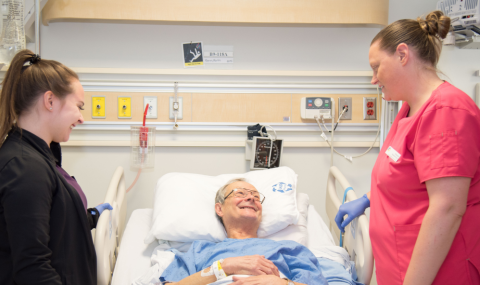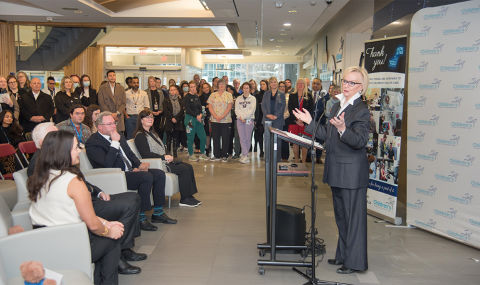MEDIA RELEASE
For Immediate Release
November 6 , 2012
November newborns leave LHSC with purple hats
LONDON, Ontario – Each November, newborns at LHSC head home for the first time wearing purple hats. The hats are handed to new parents along with an education package detailing action steps for dealing with their constantly crying infant to raise awareness about the Period of PURPLE crying - the phrase used to describe the point in a baby’s life when they cry more than any other time.
"Last November, 500 babies were born at LHSC and received purple hats,” says Kelly Barzsa Jenkins, perinatal nurse consultant, Maternal Newborn Child and Youth Network (MNCYN), LHSC. “Caregivers, typically nurses, give the hats as well as provide important information to parents regarding infant crying patterns and comforting strategies.”
In 2011, a call went out to community knitters for knitted purple hats. Since, nearly 10,000 hats have been sent to LHSC from London and surrounding area, and from as far away as Sweden. “We have been overwhelmed with the amount of community support we have received and are considering handing out purple hats throughout the year,” adds Jenkins.
The Period of PURPLE Crying is a new way for parents to understand their baby’s crying. The word PURPLE is an acronym which reminds parents in an easy to remember way all of the characteristics of normal infant crying. The letters in PURPLE stand for:
- Peak of crying – The baby may cry more each week, peaking at two months, and then less at three to five months.
- Unexpected – The crying can come and go, with no explanation.
- Resists soothing – The baby might not stop crying no matter what you try.
- Pain-like face – It may look like the baby is in pain, even when they are not.
- Long lasting – The baby might cry 5 hours per day or more.
- Evening – The baby might cry more in the late afternoon or evening.
"It is vital that parents realize infant crying is normal and have the tools to remain calm and patient around their child,” says Jenkins.
Through a generous grant from the Children’s Health Foundation in 2009, Children’s Hospital was the first hospital in Ontario to adopt the Shaken Baby Syndrome education program in their mother/newborn unit and the neonatal intensive care unit. The program includes nursing staff providing individual education to each woman/family, including a take-home 11-page colour booklet and DVD, focusing on positive messages on coping with infant crying.
About London Health Sciences Centre
London Health Sciences Centre has been in the forefront of medicine in Canada for 137 years and offers the broadest range of specialized clinical services in Ontario. Building on the traditions of its founding hospitals to provide compassionate care in an academic teaching setting, London Health Sciences Centre is home to Children’s Hospital, South Street Hospital, University Hospital, Victoria Hospital, two family medical centres, and two research institutes – Children’s Health Research Institute and Lawson Health Research Institute, a joint research initiative with St. Joseph’s Health Care London. As a leader in medical discovery and health research, London Health Sciences Centre has a history of over 50 international and national firsts and attracts top clinicians and researchers from around the world. As a regional referral centre, London Health Sciences Centre cares for the most medically complex patients including critically injured adults and children in southwestern Ontario and beyond. The hospital’s nearly 15,000 staff, physicians, students and volunteers provide care for more than one million patient visits a year. For more information visit www.lhsc.on.ca
- 30 -
For media inquiries contact:
Marek Kubow
Corporate Communications and Public Relations
London Health Sciences Centre
519-685-8500, ext. 77642
marek.kubow@lhsc.on.ca
Visit the LHSC Media web site at www.lhsc.on.ca/media
Like us on Facebook at LHSC Canada, follow us on Twitter @LHSCCanada and watch us on YouTube at LHSCCanada.


